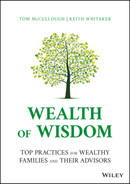SECTION 4
INVESTING WISELY
Investing is a huge topic with a vast literature devoted to it. The goal of this volume is not to offer tools or exercises aimed at making money through investing. Instead, we approach investing here not from its quantitative perspective but from the qualitative one: What should family members be thinking and talking about to make sure that their investment process enhances their lives together as a family?
Perhaps the most fundamental skill with regard to financial wealth is to identify and track the factors with the largest impact. In the first chapter in this section, Scott Peppet shares a graph that families can use to provide themselves a “stewardship snapshot” of their portfolio, in the face of the “Four Horsemen” of fees, taxes, spending (including charitable giving), and inflation. This graph allows families to keep track of their financial wealth as well as to talk specifically about what is (and is not) in their control when it comes to stewarding that wealth well.
In the next chapter, Joe Calabrese moves us from tracking wealth to setting goals, by leading readers through the simple but powerful exercise of “Capital Sufficiency Analysis.” Since families have only four options with regard to financial wealth—create it, consume it, charitably give it away, or convey it to heirs—Calabrese's exercise prompts members to think about which of those goals they want to pursue (and how to prioritize them), and then whether their current investment plan provides an expected balance of risk and return to achieve those goals (or whether they are likely to under- or overshoot them).
For families who want to pursue this line of thinking in even more detail, Jean Brunel and Voyt Krzychylkiewicz then expand on this framework with an exercise that allows readers to assign probabilities to the different types of goals they want to pursue (needs, wants, wishes, and dreams), as well as timelines for pursuing these goals. They then introduce the concept of dedicating subportfolios to these different classes of goals.
Many families seek to help their members become better stewards of their financial wealth through offering some sort of investment education. Our contributors share various tools and exercises related to family wealth education in the section entitled, “Becoming a Learning Family.” In this section, however, we have included a contribution by Jim Garland specific to family learning about investments. In it, Garland describes in detail the series of seminars that the Jeffrey family devised over several decades to educate family members about their financial assets, along with the methods of instruction and outcomes. This program provides an excellent blueprint for other families to consider and adapt to their specific needs and situation.
